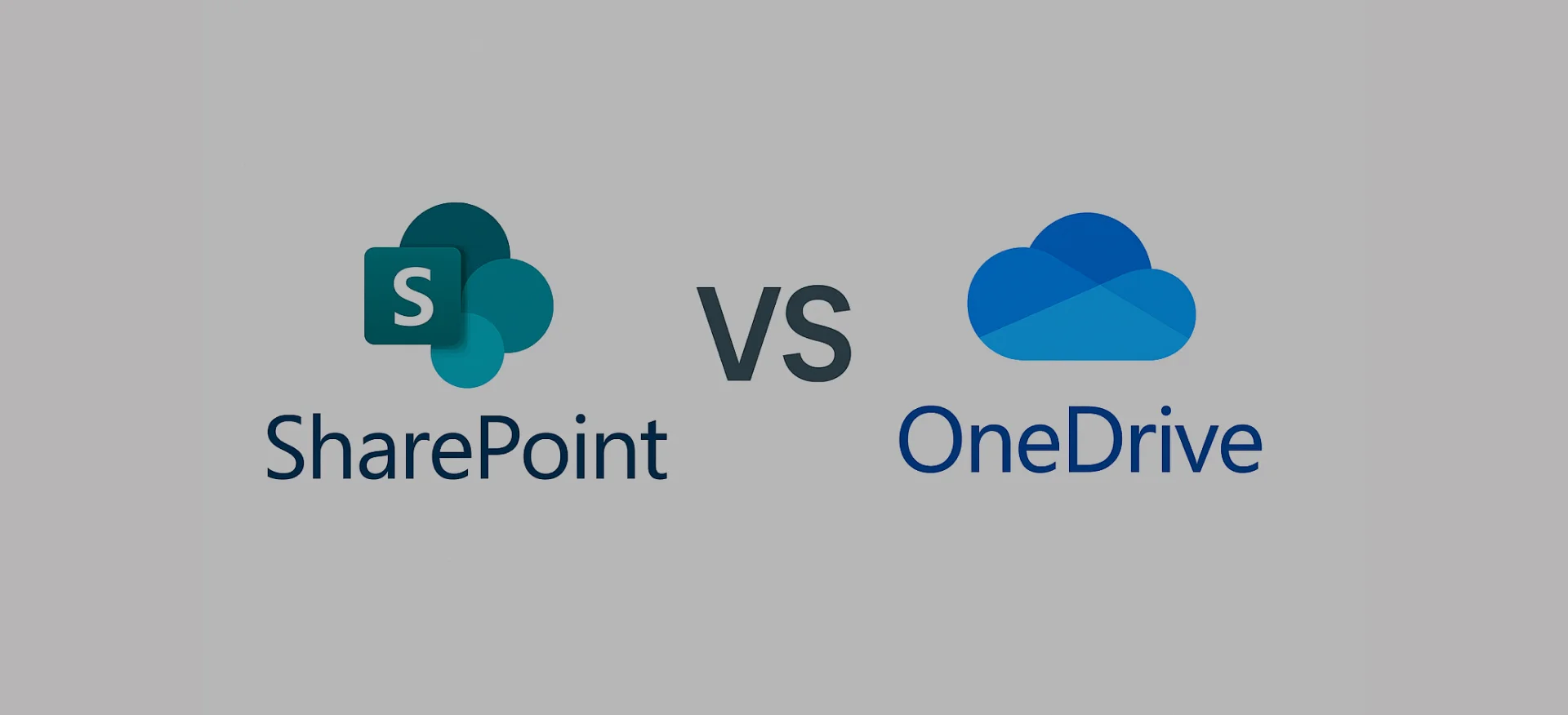Microsoft offers two powerful cloud storage and collaboration platforms: OneDrive and SharePoint, each catering to different needs.
While both work smoothly within the Microsoft 365 ecosystem, understanding the differences between SharePoint vs OneDrive is key to getting the most out of them.
OneDrive is mainly for personal cloud storage, letting individuals store, access, and share their files securely across devices. It’s perfect for personal documents, work drafts, and files that don’t require team collaboration.
SharePoint Consulting services can guide organizations in leveraging SharePoint to its full potential, ensuring it’s used optimally for team collaboration and content management.
SharePoint, on the other hand, is built for team collaboration and managing content across an organization.
Also, it allows teams to create intranet sites, share documents, and streamline workflows, making it ideal for projects that need to be worked on by multiple people with centralized access.
In this blog, we will dive deeper into the key differences between SharePoint vs OneDrive, helping you understand which platform suits your needs best.
7 Key Differences Between OneDrive and SharePoint
OneDrive is a personal cloud storage service for individual file management, while SharePoint is a collaborative platform designed for team-based content sharing and management.

|
Feature |
OneDrive |
SharePoint |
|
Usage |
Personal cloud storage for individual users. |
Collaborative platform for team and organizational content management. |
|
Primary Use Cases |
Storing personal documents, syncing files across devices. |
Creating team sites, managing shared documents, automating workflows. |
|
Ownership |
Owned by individual users. |
Managed by organizations or teams. |
|
Access Control |
Files are private by default; shared explicitly by the user. |
Permissions can be set for teams, groups, or entire organizations. |
|
Collaboration Level |
Limited to file sharing and co-authoring. |
Extensive, with tools for team collaboration, document management, and more. |
|
Customization |
Limited customization options. |
High customization with features like custom workflows, lists, and pages. |
|
Integration |
Integrates with individual Microsoft 365 apps. |
Integrates with Microsoft Teams, Power Automate, and other organizational tools. |
Explore Our SharePoint Consulting Services!
When to Use SharePoint
SharePoint is a robust platform designed to enhance team collaboration, streamline workflows, and centralize organizational content.

SharePoint Strategy & Planning ensures businesses create a tailored roadmap for successful SharePoint deployment, focusing on the integration of collaborative features, custom workflows, and enhancing team productivity.
Here are the primary scenarios where SharePoint excels:
1. Team Collaboration and Document Sharing
SharePoint provides a centralized space where teams can collaborate on documents, share resources, and communicate effectively.
Features like real-time co-authoring and version control ensure that team members are always working with the most up-to-date information.
In the case of SharePoint Strategy & Planning, consulting professionals can ensure that the platform is optimized for the best possible workflow and user experience.
It's particularly beneficial for projects that require input from multiple stakeholders.
2. Creating Intranet Sites and Dashboards
Organizations can build internal websites (intranets) using SharePoint to disseminate company news, policies, and other essential information.
These intranet sites can be customized to meet the specific needs of different departments or teams, just like using best website builders for small business allows companies to create tailored online platforms, providing a unified platform for internal communication.
SharePoint Online Intranet, businesses can create a scalable, cloud-based intranet experience that’s accessible and user-friendly.
3. Automating Business Processes and Workflows
SharePoint offers built-in workflow automation tools, such as approval processes and task assignments, to streamline business operations.
These workflows help reduce manual tasks, ensuring consistency and efficiency across various processes.
Explore Our SharePoint Online Intranet Solutions!
When to Use OneDrive
OneDrive is ideal for personal file storage, backing up documents, drafting content before team collaboration, and accessing files across multiple devices.
1. Personal File Storage and Backup
OneDrive is an excellent solution for individuals who need a safe and centralized location to store personal files such as documents, photos, videos, and music.
Whether you're working on a personal project, saving family photos, or storing important documents, OneDrive offers a secure cloud storage option.
Its automatic backup features ensure that your files are protected from potential data loss due to device failure or accidents, providing peace of mind.
2. Drafting Documents Before Team Collaboration
OneDrive is particularly useful when you need to work on documents individually before sharing them with colleagues.
It allows you to draft and refine content in isolation, such as creating reports, writing articles, or preparing presentations.
Once your draft is ready, you can easily share the document with team members for collaboration.
This makes it ideal for personal workspaces where you can gather your thoughts and then transition to collaborative work when the time is right.
3. Accessing Files Across Multiple Devices
One of the standout features of OneDrive is its ability to sync files across multiple devices. Whether you're using a laptop, smartphone, tablet, or desktop, OneDrive ensures that your files are always accessible.
This cross-platform syncing allows you to start working on a file at home, continue editing it at the office, and even access it on the go.
With OneDrive, you no longer have to worry about carrying physical storage devices or emailing files to yourself to transfer between devices; everything you need is securely stored and readily available in the cloud, similar to how easy it is to learn how to search a word on a website to quickly find information.
Integration with Microsoft 365
SharePoint vs OneDrive both integrate seamlessly with Microsoft 365 applications, enhancing collaboration and productivity within the Microsoft ecosystem.
OneDrive allows for real-time co-authoring, enabling multiple users to edit documents in Word, Excel, and PowerPoint simultaneously.
This ensures that changes are reflected in real-time, facilitating efficient collaboration.
Additionally, OneDrive offers cross-platform syncing, ensuring that files stored in OneDrive are synchronized across various devices, including Windows, macOS, iOS, and Android.
This provides users with access to their files from any device, at any time.
On the other hand, SharePoint serves as the backend for document libraries in Microsoft Teams, allowing users to access and collaborate on files directly within Teams.
SharePoint also integrates with Power Automate, automating workflows such as document approvals and notifications, streamlining business processes, , much like what is the digital marketing strategy that tracks users across the web? helps businesses analyze user behavior for optimization.
Furthermore, SharePoint supports integration with Power Apps, enabling users to build custom applications using SharePoint lists as data sources.
Additionally, SharePoint integrates with Power BI, allowing users to create interactive reports and dashboards for enhanced data-driven decision-making.
Both platforms offer valuable integration features within Microsoft 365, with OneDrive focusing more on personal file management and collaboration, while SharePoint excels in team collaboration, content management, and business process automation.
Security and Compliance in Microsoft OneDrive and SharePoint
Both OneDrive and SharePoint provide robust security and compliance features, designed to meet the needs of individual users as well as organizations.
These platforms are designed to protect data and ensure regulatory compliance, making them reliable choices for secure collaboration and file management.
1. OneDrive Security and Compliance
OneDrive offers robust security and compliance features to ensure the safety of your data.
It protects sensitive files with industry-standard encryption and provides tools for compliance with privacy regulations, similar to how top search engines secure user data while delivering search results.
OneDrive provides robust security and compliance features to ensure your files remain safe:
- Encryption: OneDrive uses AES 256-bit encryption for data at rest and TLS encryption for data in transit.
- Two-Factor Authentication (2FA): Adds an extra layer of security by requiring a second form of verification when signing in.
- Personal Vault: A secure area within OneDrive that requires strong authentication for access.
- Suspicious Activity Monitoring: Alerts you to any unusual sign-in attempts.
- Virus Scanning: Files are automatically scanned for known threats using Windows Defender.
- Zero Standing Access: Engineers do not have permanent access to the service; access is granted only when necessary and for a limited time.
- Compliance: OneDrive complies with critical industry standards and regulations, including GDPR and HIPAA, ensuring that user data is managed in accordance with privacy and data protection laws.
2. SharePoint Security and Compliance
SharePoint provides a comprehensive set of security and compliance features designed to protect sensitive data and ensure organizations meet regulatory requirements.
With its advanced security tools, retention policies, and support for eDiscovery, SharePoint offers a secure environment for managing and governing content.
- Data Encryption: Like OneDrive, SharePoint uses AES 256-bit encryption for data at rest and TLS encryption for data in transit.
- Access Controls: Role-based access controls at various levels (site, list, item) to manage permissions effectively.
- Data Loss Prevention (DLP): Prevents sensitive information from being shared inappropriately.
- Multi-Factor Authentication (MFA): Requires multiple forms of verification for service access.
- Customer Lockbox: Allows businesses to control access by requiring approval for Microsoft engineers to view your content.
- eDiscovery and Legal Hold: SharePoint supports eDiscovery searches, allowing organizations to search and preserve content for legal investigations.
Pricing and Licensing
OneDrive is included with Microsoft 365 Personal and Family plans, offering personal cloud storage for individual users.
Additional storage is available through Microsoft 365 Business and Enterprise plans, allowing businesses to scale their storage needs based on user requirements.
On the other hand, SharePoint is available through Microsoft 365 Business and Enterprise plans, designed for team collaboration and content management.
The pricing for SharePoint varies based on the plan selected and the specific needs of the organization, with different tiers offering additional features such as enhanced security, compliance, and workflow automation.
Both OneDrive and SharePoint offer flexible pricing models to accommodate personal, small business, and enterprise-level needs.
Conclusion
In summary, SharePoint vs OneDrive are both powerful tools in the Microsoft 365 ecosystem, each designed to serve distinct purposes.
OneDrive is ideal for personal file storage and syncing across devices, providing individuals with secure, easy access to their documents.
In contrast, SharePoint excels in team collaboration, document management, and business process automation, making it the preferred platform for organizations involved in software development or working with a tech marketing agency that requires shared content management and advanced collaboration features.
When deciding between OneDrive and SharePoint, it's important to assess your specific needs. If you're looking for a solution for personal storage and file syncing, OneDrive is the best choice.
However, for team-based collaboration, document sharing, and enterprise-level content management, SharePoint is the better option.
Consider your organization's requirements whether it's individual file storage or collaborative teamwork to determine which platform best suits your needs.








